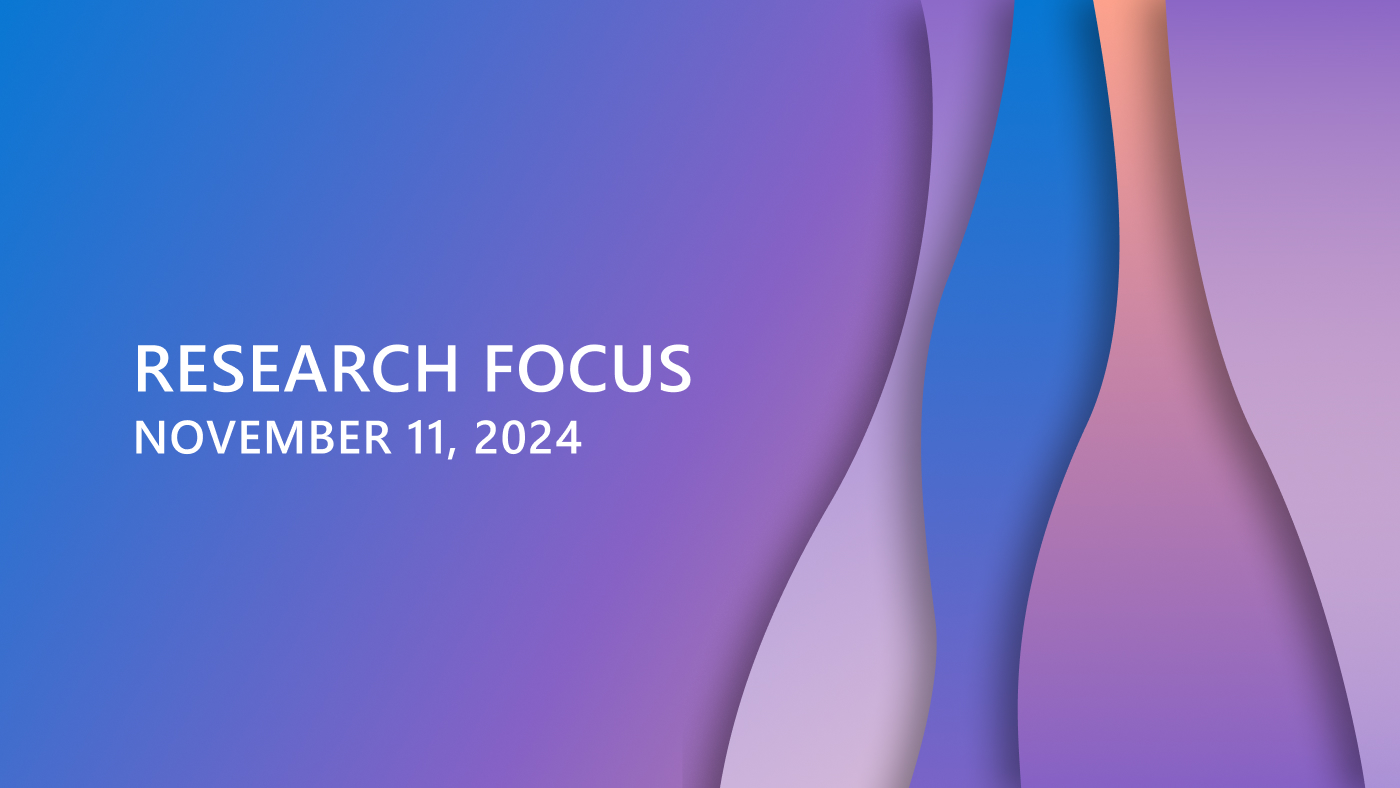Welcome to Research Focus, a series of blog posts that highlights notable publications, events, code/datasets, new hires and other milestones from across the research community at Microsoft.

EVENT RECAP
Microsoft Research Forum series kicks off with focus on the promise and challenges of AI
With a look back at the incredible changes of 2023 and a look ahead at the tangible advances to come, the inaugural Microsoft Research Forum explored bold new ideas and important issues in the era of general AI. Leaders from Microsoft Research, including the AI Frontiers team and the AI4Science lab, discussed the importance of openness and collaboration to enable successful and responsible AI research.
Peter Lee, CVP, Microsoft Research and Incubations, led off the discussion, followed by a panel exploring some of the biggest potential AI breakthroughs, along with challenges to overcome. This includes:
- Building AI systems that become helpers in the physical world
- Uncovering the building blocks of human reasoning
- Making AI technology smaller and less costly, to improve performance and availability
- Helping AI learn from people that use it, rather than simply answering questions
In the “lightning round,” Microsoft researchers explored current work to improve pretrained large language models, understand and evaluate foundation models, facilitate breakthroughs in molecular science, augment human decision making, and improve visual storytelling.
To learn more, check out this recap (opens in new tab) and browse the on-demand session replays (opens in new tab). Be sure to register for upcoming episodes (opens in new tab).
Spotlight: Blog post
NEW RESEARCH
The Truth is in There: Improving Reasoning in Language Models with Layer-Selective Rank Reduction
Transformer-based large language models (LLMs) have become a fixture in machine learning. Correspondingly, significant resources are allocated towards research to further advance this technology, typically resulting in models of increasing size that are trained on increasing amounts of data.
In a recent paper, The Truth is in There: Improving Reasoning in Language Models with Layer-Selective Rank Reduction, researchers from Microsoft demonstrate a surprising result: that it is possible to significantly improve LLM performance by selectively removing higher-order components of their constituent weight matrices. As covered in a Microsoft Research Forum lightning talk, this simple intervention—LAyer-SElective Rank reduction (LASER)—can be done on a model after training has been completed, and requires no additional parameters or data. In extensive experiments, the researchers demonstrate the generality of this finding across language models and datasets. They provide in-depth analyses offering insights into both when LASER is effective and the mechanism by which it operates.
NEW RESEARCH
Cache-Efficient Top-k Aggregation over High Cardinality Large Datasets
Business intelligence tools make it easy to analyze large amounts of data. In these tools, top-k aggregation queries are used to summarize and identify important groups of data. These queries are usually processed by computing exact aggregates for all groups and then selecting the groups with the top-k aggregate values. However, this can be inefficient for high-cardinality large datasets, where intermediate results may not fit within the local cache of multi-core processors, leading to excessive data movement.
Researchers from Microsoft, in their recent paper: Cache-Efficient Top-k Aggregation over High Cardinality Large Datasets, introduce a new cache-conscious algorithm to address this. The algorithm efficiently computes exact top-k aggregates without fully processing all groups. Aggregation over large datasets requires multiple passes of data partitioning and repartitioning, thereby presenting a significant opportunity to reduce partitioning overhead for top-k aggregation queries. The algorithm leverages skewness in data distribution to select a small set of candidate groups for early aggregation. This helps eliminate many non-candidates group partitions through efficient partitioning techniques and coarse-grained statistics without computing exact aggregation. Empirical evaluation using both real-world and synthetic datasets demonstrate that the algorithm achieves a median speed-up of over 3x for monotonic aggregation functions and 1.4x for non-monotonic functions, compared to existing cache-conscious aggregation methods, across standard k value ranges (1 to 100).
AWARDS
Six Microsoft researchers named 2023 ACM Fellows
The Association for Computing Machinery’s (ACM) annual fellows award recognizes people who make transformative contributions to computing science and technology. For 2023, the global organization named six researchers from Microsoft among its 68 award recipients.
Jianfeng Gao – VP and Distinguished Scientist
For contributions to machine learning for web search, natural language processing, and conversational systems
Sumit Gulwani – Partner Research Manager
For contributions to AI-assisted programming for developers, data scientists, end users, and students
Nicole Immorlica – Senior Principal Researcher
For contributions to economics and computation including market design, auctions, and social networks
Stefan Saroiu – Senior Principal Researcher
For contributions to memory security and trusted computing
Manik Varma – VP and Distinguished Scientist
For contributions to machine learning and its applications
Xing Xie – Senior Principal Research Manager
For contributions to spatial data mining and recommendation systems





